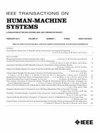A Physics-Based Virtual Reality Haptic System Design and Evaluation by Simulating Human-Robot Collaboration
IF 3.5
3区 计算机科学
Q2 COMPUTER SCIENCE, ARTIFICIAL INTELLIGENCE
引用次数: 0
Abstract
Recent advancements in virtual reality (VR) technology facilitate tracking real-world objects and users' movements in the virtual environment (VE) and inspire researchers to develop a physics-based haptic system (i.e., real object haptics) instead of computer-generated haptic feedback. However, there is limited research on the efficacy of such VR systems in enhancing operators’ sensorimotor learning for tasks that require high motor and physical demands. Therefore, this study aimed to design and evaluate the efficacy of a physics-based VR system that provides users with realistic cutaneous and kinesthetic haptic feedback. We designed a physics-based VR system, named PhyVirtual, and simulated human–robot collaborative (HRC) sequential pick-and-place lifting tasks in the VE. Participants performed the same tasks in the real environment (RE) with human–human collaboration instead of human–robot collaboration. We used a custom-designed questionnaire, the NASA-TLX, and electromyography activities from biceps, middle, and anterior deltoid muscles to determine user experience, workload, and neuromuscular dynamics, respectively. Overall, the majority of responses (>65%) demonstrated that the system is easy-to-use, easy-to-learn, and effective in improving motor skill performance. While compared to tasks performed in the RE, no significant difference was observed in the overall workload for the PhyVirtual system. The electromyography data exhibited similar trends (通过模拟人机协作设计和评估基于物理的虚拟现实触觉系统
虚拟现实(VR)技术的最新进展有助于在虚拟环境(VE)中追踪真实世界中的物体和用户的动作,并激励研究人员开发基于物理的触觉系统(即真实物体触觉),而不是计算机生成的触觉反馈。然而,对于需要高运动和高体能要求的任务,此类 VR 系统在增强操作员感知运动学习方面的功效,目前的研究还很有限。因此,本研究旨在设计和评估基于物理的 VR 系统的功效,该系统可为用户提供逼真的皮肤和运动触觉反馈。我们设计了一个名为 PhyVirtual 的基于物理的 VR 系统,并在 VE 中模拟了人机协作(HRC)的顺序拾放搬运任务。参与者在真实环境(RE)中通过人与人之间的协作而不是人与机器人之间的协作来完成同样的任务。我们使用定制的调查问卷、NASA-TLX 以及肱二头肌、中肌和三角肌前肌的肌电图活动来分别确定用户体验、工作量和神经肌肉动态。总体而言,大多数反馈(>65%)表明该系统易于使用、易于学习,并能有效提高运动技能表现。与在 RE 中执行的任务相比,PhyVirtual 系统的总体工作量没有明显差异。两种环境下的肌电图数据呈现出相似的趋势(p > 0.05;r > 0.89)。这些结果表明,PhyVirtual 系统是模拟现代仓储环境中常见的安全人机协作的有效工具。此外,它还可以在广泛的领域替代现场传感器运动训练。
本文章由计算机程序翻译,如有差异,请以英文原文为准。
求助全文
约1分钟内获得全文
求助全文
来源期刊

IEEE Transactions on Human-Machine Systems
COMPUTER SCIENCE, ARTIFICIAL INTELLIGENCE-COMPUTER SCIENCE, CYBERNETICS
CiteScore
7.10
自引率
11.10%
发文量
136
期刊介绍:
The scope of the IEEE Transactions on Human-Machine Systems includes the fields of human machine systems. It covers human systems and human organizational interactions including cognitive ergonomics, system test and evaluation, and human information processing concerns in systems and organizations.
 求助内容:
求助内容: 应助结果提醒方式:
应助结果提醒方式:


